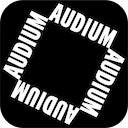LEONARDO
Journal of the International Society for the Arts
Sciences and Technology, MIT Press
Volume 35, Number 3, 2002
AUDIUM: SOUND-SCULPTURED SPACE
by Stanley Shaff
The interaction between compositional needs and technological innovation led to the creation of AUDIUM, variously described as a theatre of sound-sculptured space or a sound-space continuum. Located in San Francisco, AUDIUM is a total environment, designed from floor to ceiling as an integrated concept.
The theatre, open since 1975, consists of a foyer, a sound labyrinth and a main performance space. It is a building within a building, conceived directly for this art form. Listeners sit in concentric circles, enveloped by 169 speakers in sloping walls, floating floor, and a suspended ceiling (Fig. 1). Sounds travel above, around, below, and on multidimensional planes in space. Exact control of sound movement, direction, speed and intensity is realized through a custom-designed electronic console, responsive to a “tape performer.” Live, spatial performance of tape compositions allows each performance to be unique. Listeners are immersed in a kinetic sound realm wherein speakers and environment become the new electronic orchestra.
The idea of AUDIUM began taking shape in 1958, when Doug McEachern and I met. We were both musicians and teachers, with traditional music backgrounds. I was working with tape (natural and electronic sounds) and becoming concerned with the spatial aspects of composition and perception. Doug’s knowledge of electronics enabled him to develop original equipment systems for live, spatial performances.
In the beginning, we operated with a simple performance console allowing for spatial movement among a limited number of speakers. We held several public performances in San Francisco colleges and museums beginning in 1960. Gradually, we developed a strong philosophy about the effect of the total environment on the composition. This led to our first permanent theatre, open for 3 1/2 years beginning in 1967.
In our second and current theatre, we had the opportunity to build on what we had learned with seed money from the NATIONAL ENDOWMENT FOR THE ARTS. We have been offering weekly public performances and occasional college seminars since 1975.
AUDIUM has sought to bring listeners physically inside a sound world, where they can experience sounds as kinetic, sculptural, shaping energies. As sounds travel in total darkness, they create textures, colors and forms. Polytonal writing allows chordal clusters to interact on different levels in space. Through the workings of sound tensions and releases, the pushing and pulling of harmonics, the audio space expands and contracts.
A melodic line acquires a starting point, a speed, a determined pathway, and a point of conclusion. Areas in space become launching sites and meeting stations for converging sound lines. Melodic convolutions can be physically felt as they flow along spatial planes – vertical, horizontal, diagonal, circular, and any desired combination thereof. As each melodic line travels, layers unfold, overlap and entwine to reveal a rich audio tapestry.
In seeking to understand the language of space, we hope to have brought new perceptual understandings to a largely neglected dimension in the vocabulary of music.
